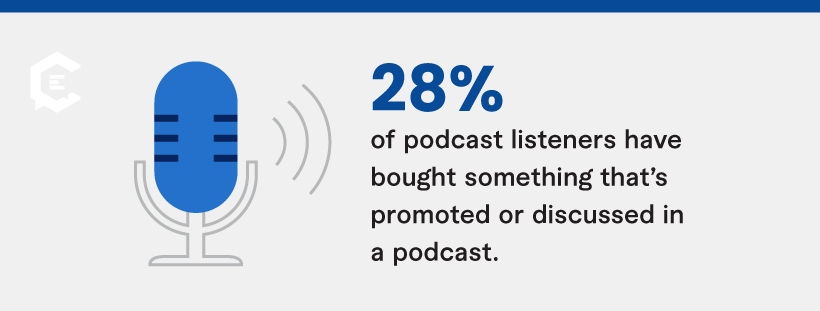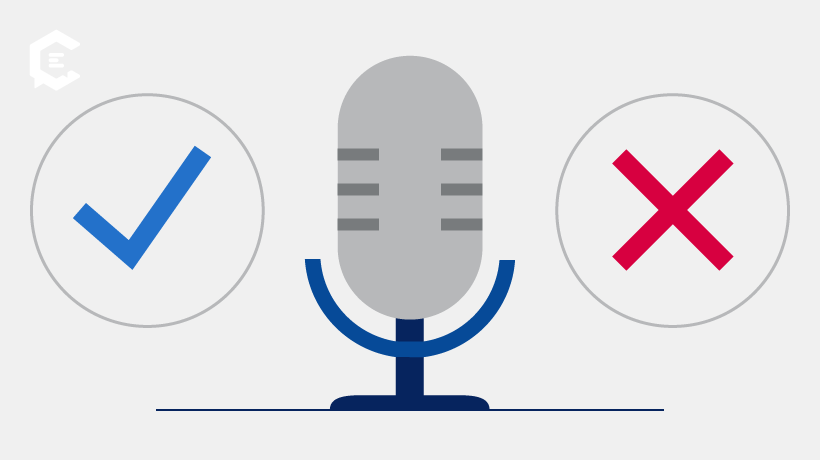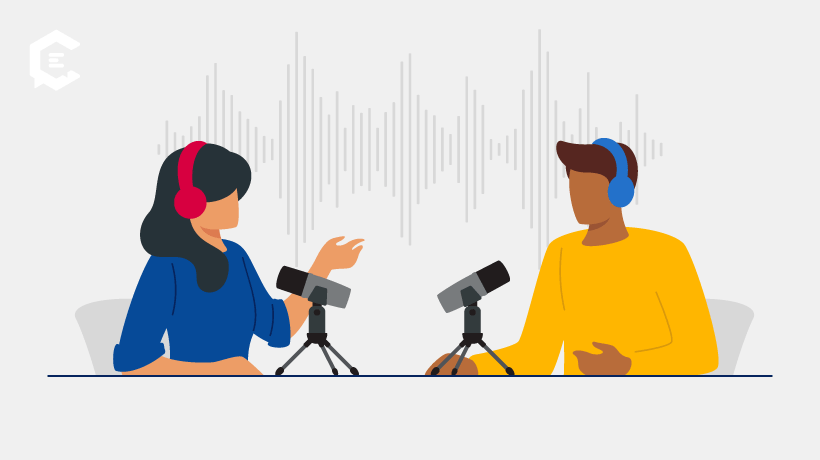From political commentators to finance gurus, it seems like everyone’s jumped on the podcast bandwagon. And podcast content is everywhere — whether it’s a snippet on your Instagram Explore or a suggested video on your YouTube feed. So, for anyone that’s paying attention, it’s easy to feel like you’re missing out on the next big thing.
For marketing leaders, the pressure’s even higher. The exposure and engagement opportunities from a successful branded podcast are hard to ignore. But podcasting isn’t the right content fit for every industry. And the risks involved in trying out a new format – the time and money that’s needed to invest in the latest fad — might do more harm than good for your business.
Before you buy a microphone and hit record, let’s discuss the pros and cons so you can confidently decide if it’s really worth it to start a podcast. Will it increase your brand awareness and build loyalty? Or will you be speaking into the void?
Is the podcast market oversaturated or a business opportunity?
The abundance of personal podcasts flooding the scene could make it seem like the podcast market is oversaturated. And there’s a certain level of truth to it. Podcast Index reports that there are over 4.5 million podcasts worldwide as of 2025.
But does that mean that your brand should avoid podcast marketing altogether? Not necessarily. Most of the fatigue people feel around podcasts and podcasters is specific to the personal kind. These podcasts feature an individual or a group of individuals discussing their opinions and experiences, typically for self-expression.
Branded podcasts, on the other hand, focus primarily on sharing content that is educational and delivers value. From commentary on the latest industry trends to deep dives that break down complex topics, podcasting is the perfect opportunity for brand storytelling and building audience relationships.
In fact, podcasts are highly influential in generating brand awareness and driving buying decisions. Pew Research Center found that 60% of podcast listeners get recommendations for books, music, and movies from podcasts. And 28% have even bought something that’s promoted or discussed in a podcast.
Remarkably, the industry continues to grow, with podcast revenue in the U.S. slated to reach $2.38 billion in 2025. As competition increases, though, discoverability becomes more of a challenge. Getting your podcast in front of the right audience — a loyal and engaged listener base that regularly tunes into your episodes — is paramount.
Branded Podcasts vs. Other Content Formats
One of the biggest draws of podcasting for businesses is that it usually delivers a high return on investment (ROI). HubSpot found that podcasts and audio content rank fourth among content formats delivering high ROI. Short-form video continues to reign supreme, followed by images and live-streamed video.
This indicates that podcast ROI surpasses that of text-heavy formats like blogs and long-form content. Yet podcasts still don’t compare with visual content formats. Combining podcasts with visuals to create video podcasts could help to maximize your ROI.
Audience considerations
You’ll also need to consider the consumption habits of your target audience. Podcast listeners in the U.S. are most likely to tune into comedy content, followed by topics related to society and culture. News, true crime, sports, education, business, and health and fitness are also popular genres.
Consider where your business falls within these genres. Does a branded podcast make sense? Will your audience want to engage with podcast content enough to deliver ROI?
Investment considerations
Starting a podcast requires significantly more investment compared with content formats like blogs and images. Even the most basic setup calls for podcasting equipment like microphones, headphones, and recording/editing software, in addition to a computer.
You’ll also need to factor in ongoing production expenses to get an accurate idea of your podcast ROI. Although the amount may not be as high as the cost of producing videos, you’ll need to account for fees related to podcast hosting, editing, licensing, guests, promotion, and so on. Keep talent in mind as well, as podcast production may require skills that aren’t internally available. Consider your team’s bandwidth and expertise, and whether you’d need to outsource.
Weighing the Pros and Cons of Podcasting
ROI aside, how do you determine if podcasting is the right investment for your content marketing strategy? Let’s explore the benefits and disadvantages of branded podcasts.
Key benefits of branded podcasts
- It creates an opportunity to share thought leadership content and build your brand authority. Podcasts give you the freedom to dig deeper into relevant industry topics and share your expertise.
- Podcasting allows for content multiplication and content repurposing. For example, you could turn snippets from your podcast into short-form video content. Podcast transcripts could also help you build out informative blog posts.
- The conversational nature of podcast content helps increase audience engagement. The more engaged your audience is, the easier it is to foster relationships, trust, and loyalty.
- Compared with video production and full-fledged ad campaigns, podcasts are more cost-effective.
What are the potential disadvantages of creating a podcast?
- Maintaining a regular production schedule requires a significant time commitment. For instance, you need to consistently set aside time to research topics, book guests, record episodes, edit your recordings, and promote the content.
- Most podcast listeners expect a refined production quality. There’s a lot of work and technical knowledge required to meet these expectations, especially in the post-production stage. You need skills to fine-tune your audio, remove background noise, add music and sound effects, and more.
- Podcasting often lacks precise measurement tools. Engagement data alone may not be enough to quantify ROI, and downloads don’t necessarily guarantee that people listened to the podcast. All these factors make it challenging for brands to justify the investment.
Should your brand start a podcast?
Still not sure if podcasting is the way to go? Here are a few questions to ask yourself before making a decision:
- Does podcasting align with my marketing goals?
- Would a branded podcast align with my target audience’s behavior? (i.e., Does my target audience tune in to podcast content?)
- Do I have any gaps in my current content strategy that podcasting might fill?
- Do I have the resources and in-house skills needed to create and run a podcast?
- Do I have the budget to outsource tasks where I lack in-house talent?
- Do I have the long-term commitment available to maintain a regular podcast schedule?
- Do I have subject matter expertise or compelling content angles to offer?
Moving Forward with Podcasting or Exploring Alternatives
If you’ve decided that podcasting is the right move for your brand, here are a few best practices on how to create a podcast:
- Define measurable goals. What do you want to achieve through podcasting? How will you measure success?
- Commit to consistency over perfection. Maintaining a consistent publication schedule should come first over perfection. It shows commitment and reliability, helping you build a loyal listener base.
- Invest in quality audio. Make sure listeners don’t have to strain to hear what you have to say. Remove background noise and enhance your audio quality to ensure clarity.
- Focus on serving your audience, not selling. Your podcast should be less about pushing your product and more about helping audiences realize the value you offer.
- Plan ahead for content distribution. How will you get your podcast in front of the right listeners? Decide on the distribution channels and promotion strategy ahead of time.
- Be patient and track the right metrics. You may not get the desired results immediately after your content goes live. Take the time to figure out what’s working by tracking relevant performance metrics, such as engagement, clicks, and downloads. Then use those insights to inform your podcasting strategy.
- Develop sustainable production workflows. Setting up a proper production workflow and replicating it for every episode will help you maintain consistency.
If podcasting doesn’t align with your current needs, there are plenty of alternative options to explore. Perhaps your audience will appreciate thought leadership blog posts. Or maybe they’ll gain more value from interactive content. For visual learners, webinars and infographics may be the way to go.
Build a Content Strategy That Works for Your Brand
To podcast or not to podcast?
Regardless of what you decide, working with a team of content experts can set you up for success. That’s where ClearVoice comes in. Whether you need help researching topics and writing scripts for your next podcast or scaling your blog production, we can help. Explore our managed content solutions, and connect with a content specialist today to get started.






